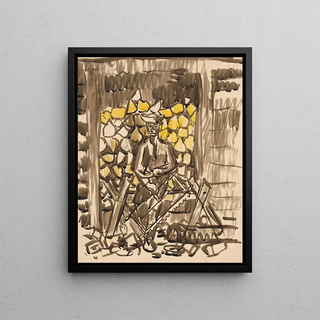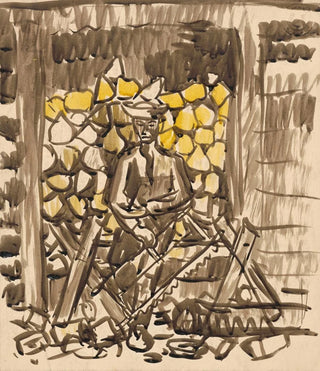Wood sawing painting - Arnold Peter Weisz-Kubínčan | Art print


View from behind

Frame (optional)
In the vibrant world of art, some works manage to capture the essence of an era while resonating deeply with human emotions. "Wood sawing" by Arnold Peter Weisz-Kubínčan is one of those striking creations that provoke and fascinate. This painting, both simple and evocative, immerses us in a scene of everyday life, revealing the subtleties of manual labor and the beauty of toil. Through this artwork, the artist succeeds in immortalizing a fleeting moment, transforming the ordinary into the extraordinary. The art print Sciage du bois - Arnold Peter Weisz-Kubínčan allows us to appreciate this scene with renewed intensity, offering a glimpse into the culture and traditions of a bygone era.
Style and uniqueness of the work
Weisz-Kubínčan's style is distinguished by a realistic approach that combines meticulous details with an intimate atmosphere. In "Sciage du bois," the characters, although depicted figuratively, seem almost alive, as their posture and concentration testify to a sincere engagement with their task. Light plays a crucial role in this work, illuminating the faces and gestures of the workers while creating shadows that add depth to the composition. The choice of colors, both earthy and vibrant, evokes the warmth of a familiar and rural environment, inviting the viewer to feel the texture of the wood and the roughness of the work. This attention to detail, combined with strong visual storytelling, gives the piece a singularity that leaves no one indifferent.
The artist and his influence
Arnold Peter Weisz-Kubínčan, a Slovak-born artist, established himself in the art world in the early 20th century. His academic training and diverse influences, ranging from realism to post-impressionism, allowed him to develop a personal style that blends tradition and modernity. Weisz-Kubínčan often drew inspiration from everyday life, seeking to depict the beauty of simple gestures and human interactions. His work transcends cultural boundaries, and "Sciage du bois" is a perfect example, as

Matte finish

View from behind

Frame (optional)
In the vibrant world of art, some works manage to capture the essence of an era while resonating deeply with human emotions. "Wood sawing" by Arnold Peter Weisz-Kubínčan is one of those striking creations that provoke and fascinate. This painting, both simple and evocative, immerses us in a scene of everyday life, revealing the subtleties of manual labor and the beauty of toil. Through this artwork, the artist succeeds in immortalizing a fleeting moment, transforming the ordinary into the extraordinary. The art print Sciage du bois - Arnold Peter Weisz-Kubínčan allows us to appreciate this scene with renewed intensity, offering a glimpse into the culture and traditions of a bygone era.
Style and uniqueness of the work
Weisz-Kubínčan's style is distinguished by a realistic approach that combines meticulous details with an intimate atmosphere. In "Sciage du bois," the characters, although depicted figuratively, seem almost alive, as their posture and concentration testify to a sincere engagement with their task. Light plays a crucial role in this work, illuminating the faces and gestures of the workers while creating shadows that add depth to the composition. The choice of colors, both earthy and vibrant, evokes the warmth of a familiar and rural environment, inviting the viewer to feel the texture of the wood and the roughness of the work. This attention to detail, combined with strong visual storytelling, gives the piece a singularity that leaves no one indifferent.
The artist and his influence
Arnold Peter Weisz-Kubínčan, a Slovak-born artist, established himself in the art world in the early 20th century. His academic training and diverse influences, ranging from realism to post-impressionism, allowed him to develop a personal style that blends tradition and modernity. Weisz-Kubínčan often drew inspiration from everyday life, seeking to depict the beauty of simple gestures and human interactions. His work transcends cultural boundaries, and "Sciage du bois" is a perfect example, as
12,34 €






